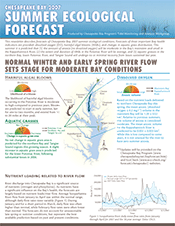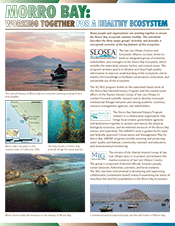2007 Chesapeake Bay summer ecological forecast
 In collaboration with the Chesapeake Bay Program, EcoCheck (NOAA-UMCES Partnership) has produced the Chesapeake Bay summer ecological forecast for the third year. The EcoCheck forecast website and newsletter describe forecasts of three important Bay health indicators–dissolved oxygen (DO), harmful algal blooms (HABs), and changes in aquatic grass distribution. This summer it is predicted that (1) amount of anoxia (no dissolved oxygen) will be moderate in the Bay's mainstem and small in the Rappahannock River, (2) the extent and duration of HABs in the Potomac River will be average, and (3) aquatic grasses in the northern Bay, lower Potomac River, and Tangier Sound will undergo no or minimal recovery from losses sustained last year. For further information, visit the Chesapeake Bay Program and EcoCheck bay forecast pages.
In collaboration with the Chesapeake Bay Program, EcoCheck (NOAA-UMCES Partnership) has produced the Chesapeake Bay summer ecological forecast for the third year. The EcoCheck forecast website and newsletter describe forecasts of three important Bay health indicators–dissolved oxygen (DO), harmful algal blooms (HABs), and changes in aquatic grass distribution. This summer it is predicted that (1) amount of anoxia (no dissolved oxygen) will be moderate in the Bay's mainstem and small in the Rappahannock River, (2) the extent and duration of HABs in the Potomac River will be average, and (3) aquatic grasses in the northern Bay, lower Potomac River, and Tangier Sound will undergo no or minimal recovery from losses sustained last year. For further information, visit the Chesapeake Bay Program and EcoCheck bay forecast pages.
Morro Bay: Working together for a healthy ecosystem
 Morro Bay, on the central California coast, was the site of a workshop to develop a conceptual framework for an ecosystem-based management initiative. IAN staff worked with Morro Bay scientists, resource managers, and stakeholders to develop conceptual diagrams for Morro Bay, offshore Estero Bay and the Morro Bay watershed. These diagrams examined key features, threats, and management objectives of the Morro Bay ecosystem. A suite of science communication products was generated: conceptual diagrams, a science newsletter, a poster, and visual materials for the web. The Morro Bay regional initiative is the first of three Packard Foundation ecosystem-based management projects (the other two are Palau and the Sea of Cortez) with whom IAN will partner with to produce conceptual frameworks.
Morro Bay, on the central California coast, was the site of a workshop to develop a conceptual framework for an ecosystem-based management initiative. IAN staff worked with Morro Bay scientists, resource managers, and stakeholders to develop conceptual diagrams for Morro Bay, offshore Estero Bay and the Morro Bay watershed. These diagrams examined key features, threats, and management objectives of the Morro Bay ecosystem. A suite of science communication products was generated: conceptual diagrams, a science newsletter, a poster, and visual materials for the web. The Morro Bay regional initiative is the first of three Packard Foundation ecosystem-based management projects (the other two are Palau and the Sea of Cortez) with whom IAN will partner with to produce conceptual frameworks.
Breath of life: Dissolved oxygen in Chesapeake Bay
 In collaboration with Dave Jasinski (CBP-UMCES), EcoCheck has produced a background newsletter about dissolved oxygen. This newsletter describes why dissolved oxygen is an important indicator of ecosystem health. It focuses on dissolved oxygen in Chesapeake Bay and its tributaries and describes the factors, such as nutrients and temperature, that affect dissolved oxygen. Additionally, the management decisions and actions that are being taken to reduce the amount of low dissolved oxygen in the Bay are described. The newsletter can be downloaded from the EcoCheck webpage. For further information on dissolved oxygen, visit the Chesapeake Bay Program's dissolved oxygen page.
In collaboration with Dave Jasinski (CBP-UMCES), EcoCheck has produced a background newsletter about dissolved oxygen. This newsletter describes why dissolved oxygen is an important indicator of ecosystem health. It focuses on dissolved oxygen in Chesapeake Bay and its tributaries and describes the factors, such as nutrients and temperature, that affect dissolved oxygen. Additionally, the management decisions and actions that are being taken to reduce the amount of low dissolved oxygen in the Bay are described. The newsletter can be downloaded from the EcoCheck webpage. For further information on dissolved oxygen, visit the Chesapeake Bay Program's dissolved oxygen page.
Two positions available
 Emily Benson finished her IAN internship to start graduate school at the University of Alaska. Emily's internship included having her stable isotope manuscript on Upper Saranac Lake accepted for publication in Hydrobiologia. She will be replaced by Emily Nauman from Miami University (of Ohio). Kate Boicourt, a science communicator with EcoCheck, will also start graduate school at Yale University, having played a key role in finalizing the National Estuarine Eutrophication Assessment report. A replacement EcoCheck Science Communicator position is currently being advertised. Sewelo Sewelo Keleagetse, a GIS specialist at the Chesapeake Bay Program, has resigned to work closer to his Pennsylvania home, and a replacement position is currently being advertised. For further details visit the UMCES employment page.
Emily Benson finished her IAN internship to start graduate school at the University of Alaska. Emily's internship included having her stable isotope manuscript on Upper Saranac Lake accepted for publication in Hydrobiologia. She will be replaced by Emily Nauman from Miami University (of Ohio). Kate Boicourt, a science communicator with EcoCheck, will also start graduate school at Yale University, having played a key role in finalizing the National Estuarine Eutrophication Assessment report. A replacement EcoCheck Science Communicator position is currently being advertised. Sewelo Sewelo Keleagetse, a GIS specialist at the Chesapeake Bay Program, has resigned to work closer to his Pennsylvania home, and a replacement position is currently being advertised. For further details visit the UMCES employment page.

